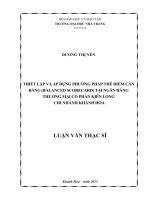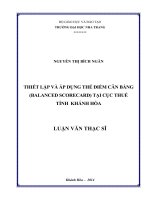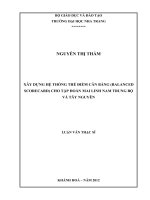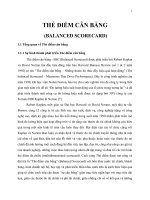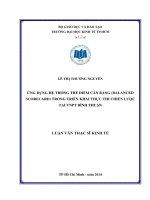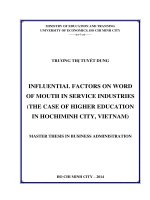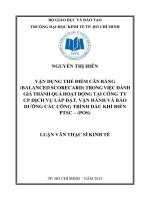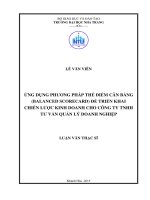Luận văn thạc sĩ Vận dụng thẻ điểm cân bằng (Balanced Scorecard) tại công ty CP vận tải dầu khí Cửu Long
Bạn đang xem bản rút gọn của tài liệu. Xem và tải ngay bản đầy đủ của tài liệu tại đây (1.14 MB, 104 trang )
MINISTRY OF EDUCATION AND TRANNING
UNIVERSITY OF ECONOMICS, HO CHI MINH CITY
TRNG TH TUYT DUNG
INFLUENTIAL FACTORS ON WORD
OF MOUTH IN SERVICE INDUSTRIES
(THE CASE OF HIGHER EDUCATION
IN HOCHIMINH CITY, VIETNAM)
MASTER THESIS IN BUSINESS ADMINISTRATION
HO CHI MINH CITY – 2014
MINISTRY OF EDUCATION AND TRANNING
UNIVERSITY OF ECONOMICS HO CHI MINH CITY
TRNG TH TUYT DUNG
INFLUENTIAL FACTORS ON WORD
OF MOUTH IN SERVICE INDUSTRIES
(THE CASE OF HIGHER EDUCATION
IN HOCHIMINH CITY, VIETNAM)
Subject: Master of Business Administrator
Code: 60.34.05
MASTER THESIS IN BUSINESS ADMINISTRATION
SUPERVISOR:
Dr. TRN HÀ MINH QUÂN
HO CHI MINH CITY – 2014
1
ACKNOWLEDGEMENT
I would like to express my great gratitude to my supervisor, Dr. Trn Hà
Minh Quân, for his wonderful knowledge, patient and kind guidance throughout this
research.
I would like to thank all of my respected lecturers of the eMBA19 course for
their efforts and dedication in training us.
I am appreciative my classmates for their kind support and encouragement.
Finally, I would like to dedicate this study to my mom, my husband, and my
sister, who always love and encourage me to pursue with my study.
Ho Chi Minh City, January, 2014,
Trng Th Tuyt Dung
2
COMMITMENT
I would like to commit that this thesis, “Influential factors on word of mouth
in service industries (the case of higher education in Hochiminh city, Vietnam)”,
was accomplished based on my independent and serious study and scientific
research. The data was collected in reality and it has clear origins. In addition to that,
the data would be trust-worthily handled and it has never been released in any menu.
Trng Th Tuyt Dung
3
TABLE OF CONTENT
ABSTRACT 7
CHAPTER 1 INTRODUCTION 8
1.1. Introduction 8
1.2. Research Objectives 10
1.3. Research methodology and research scope 11
1.4. Significances of the research 11
1.5. Structure of the research 12
CHAPTER 2 LITERATURE REVIEW 12
2.1. Introduction 12
2.2. Higher education as a service 13
2.3. Word-of-Mouth (WOM) 13
2.3.1. Definition & characteristics 13
2.3.2. Role of WOM in decision of consumers 15
2.3.3. Effectiveness of WOM 17
2.4. Development of research model and hypothesis 18
2.4.1. Satisfaction 18
2.4.2. Loyalty 19
2.4.3. Service quality 20
2.4.4. The perceived value 21
2.4.5. Trust 22
2.4.6. Reference intention to enroll 23
2.4.7. Proposed conceptual model and hypotheses 23
2.5. Summary 24
CHAPTER 3 RESEARCH METHODOLOGY 25
3.1. Introduction 25
3.2. Research design 25
3.2.1. Research methodology 25
3.2.2. Research process 26
3.3. Measurement scales and questionnaire development 27
3.3.1. Measurement scales 27
3.3. 2. Questionnaire development 29
3.3.3. Questionnaire design 29
3.4. Pilot study 30
3.4.1. Qualitative pilot study 30
3.4.2. Quantitative pilot study 30
3.5. Quantitative main study 31
3.5.1. Research sampling 31
3.5.2. Collecting data 31
3.5.3. Methods of data analysis 31
3.5.4. Data cleaning 32
3.5.5. Reliability assessment of measurement scales (Cronbach's alpha) 32
3.5.6. Exploratory factor analysis (EFA) 32
3.5.7. Confirmatory factor analysis (CFA) and SEM: 34
3.5.8. Bootstrap Method 36
3.6. Summary 36
CHAPTER 4 DATA ANALYSIS AND FINDINGS 37
4
4.1. Introduction 37
4.2. Descriptions of sample 37
4.3. Reliability and validity of the measurement scale 38
4.3.1. Reliability (Cronbach’s alpha) 39
4.3.2. Exploratory factor analysis (EFA) 41
4.3.2.1. EFA implementation for independent variables 41
4.3.2.2. EFA implementation for dependent variable 45
4.3.2.2.1. EFA for Word of Mouth (WOM): 45
4.3.2.2.2. EFA for Reference Intention (INT): 46
4.3.3 Confirmatory Factor Analysis: 47
4.4. Adjust the research model and the hypotheses 50
4.4.1. The adjusted research model 50
4.4.2. The adjusted research hypothesis 51
4.5. Testing the adjusted research model and the hypotheses 51
4.5.1. Testing the adjusted research model 51
4.5.2 Results of testing hypotheses 54
4.5.3. Boostrap test 56
4.6. Summary 57
CHAPTER 5 CONCLUSION AND IMPLICATION 58
5.1. Introduction 58
5.2. Findings 58
5.3 Recommendations 58
5.4. Limitation and future research 59
LIST OF REFERENCES 60
APPENDIX 1 QUESTIONNAIRE 71
APPENDIX 2 CRONBACH’S ALPHA ANALYSIS 79
APPENDIX 3 EXPLORATORY FACTOR ANALYSIS (EFA) 82
APPENDIX 4 CFA , SEM RESULTS 87
5
LIST OF TABLE
Table 1.1: Definitions of Word-of-Mouth 13
Table 3.1. Measurement scales of variables 28
Table 4.1. Demographic characteristics of the respondents 38
Table 4.2. Cronbach‟s alpha of variables 39
Table 4.3. KMO and Bartlett's Test 41
Table 4.4. Total Variance Explained 42
Table 4.5. Rotated Component Matrix 43
Table 4.6. EFA results of independent variables 44
Table 4.7. EFA results of WOM variable 46
Table 4.8. EFA results of Reference Intention Variable 47
Table 4.9. Decriptive statistics, factor loads and Cronbach‟s alpha coefficients 48
Table 4.10. Pearson Correlation 49
Table 4.11. Results of testing hypothesis 55
Table 4.12. Square multiple Correlations (R
2
) 56
Table 4.13 Boostrap results with N = 500 56
6
LIST OF FIGURE
Figure 2.1. Proposed conceptual model of the research 24
Figure 3.1. Research process 26
Figure 4.1. Standardized measurement model of variables 50
Figure 4.2. The adjusted research model 51
Figure 4.3. Initial Structure Model 52
Figure 4.4. Nonstandard regression of the modified structural model 53
Figure 4.5. Standard regression of modified structural model 54
7
ABSTRACT
This study aims to exam the factors effective in the formation of word-of-
mouth about the services of higher education and their results among students in Ho
Chi Minh City.
A structural model with dimensions of factors affecting word-of-mouth,
word-of-mouth and their results was tested with a sample of 223 students of higher
educational institutions in Ho Chi Minh City, Vietnam.
The results of the study indicate that to Vietnamese consumers, perceived
value, satisfaction and loyalty are factors effective in the formation of Word of
mouth about higher educational institutions and Word of Mouth can affect on
students‟ intention to refer to enroll at the institutions. These findings suggest that
educational managers should make efforts to improve their mental image in students
and to make students more satisfied in order to encourage them producing positive
word-of-mouth about the organization.
KEYWORDS: word of mouth, Hochiminh City, higher education,
consumer‟s behavior
8
CHAPTER 1
INTRODUCTION
1.1. Introduction
From marketer perspective, Word-of-mouth (WOM) is an important area and
a key player for marketing research as this form of communication is regarded to
have greater influences on other people‟s choices compared to other forms of
communication (Murray, 1991; Day, 1971) and thus, more effective than other
marketing tools and conventional advertising media (Engel et al., 1969; Katz and
Lazarfeld, 1955). Although a WOM communication can be very influential in any
purchase decision, previous researches suggest that its influence seems to be greater
in services contexts (Ettenson and Turner, 1997; Murray, 1991). Even within the
service sector, WOM seems to have different influences in different service
contexts because risk is regarded higher in some service purchase situations than it
is in others (Bansal and Voyer, 2000; Still et al., 1984). Education is a special
service situation in which WOM seems to be significant (Cook and Zallocco, 1983;
Mazzarol and Soutar, 2002).
In Vietnam, education always plays a central role in culture and society.
With a densely-populated country with a population of 86 million people and with
more than 60% under the age of 35 (Source: General Department of Statistics of
Vietnam, 2009), Vietnam‟s education emerges huge needs for this young
population. Moreover, as a developing country with strong industrial growth,
expanding foreign investment and a booming private sector, Vietnam need a variety
of workplaces skills, including technology and management knowledge; therefore,
high demand for good quality training is generated for education in Vietnam (Maine
International Trade Center, 2010 ).
The Higher Education Reform Agenda 2006-2020 has built to aim on
changing education environment, resulting in a growth in the number of public,
9
semi-public and private higher education institutions. However, despite the number
of higher institutions in Vietnam has doubled for the last 10 years (from 153 in 2000
to 369 in 2008, and even more today) (cited in Runckel, 2012) and the government
has issued $456.5 million in loans (Source: World Bank, 2010) aimed at improving
Vietnam‟s higher education system, only about 1.6 million (about 2% of Vietnam
population) are at higher education institutions (Runckel, 2012); i.e., Vietnam‟s
proportion of college students is still half that of Thailand and a third that of South
Korea (Maine International Trade Center, 2010). Moreover, according to data from
MOET in 2007, higher education in Vietnam faces many challenges such as ratio of
students to faculty is low at 1/30; quality of faculty is not as high as needed (for
example, only 14% of faculty have a doctoral degree and 33% have a masters
degree); quality assurance in education remains weak; enrollment is concentrated in
a few academic disciplines (nearly 50% of all students major in economics/
business). Therefore, it is a requirement for higher education institutions to make
efforts to meet demand of modern business society.
In addition, as higher education provision is a service and students are
expected to pay fees for their educational trainings, it seems appropriate that higher
education institutions make a shift from being product-led ( i.e., relying on the
product to sell) towards a more “customer-led” approach (Angell et al., 2008).
When consumers (in this context, students) makes an uncertain and high-risk
decision in service industries (like choosing a university), they may rely heavily on
WOM communications such as the advice and suggestions from others who have
experienced the service (Kinard and Capella, 2006). Moreover, WOM‟s importance
is highlighted as consumers often trust each other more than they trust
communication from organizations (Zeithaml and Bitner, 1996). As a result,
educational managers need to understand the formation of WOM and its role in
their organizations‟ success.
Studies on WOM have exposed that its effectiveness is relied on the
overwhelming influence which it makes on consumer behavior. Reicheld (1996)
10
points out that these effects are enlarged by a higher degree of customer loyalty and
profitability. Researchers have found that WOM is strongly and positively
connected with consumers‟ levels of trust (Bergeron at al, 2003), service quality
(Parasuraman et al, 1988), satisfaction (Anderson, 1998), perceived value (Hartline
& Jones, 1996), relationship quality (Boles et al., 1997), and with consumers‟
intention to purchase (Crocker, 1986). Furthermore, within the higher education
context, Athiyaman (1997) found that student attitude to the university is positively
related to positive WOM subsequent to their enrolment (post-enrolment
communication behavior). More recently, Jayawardhena & Wright (2009) add
further distribution when they find excitement positively influences on positive
WOM. Especially, Yasvari et al. (2012) propose and empirically test a
comprehensive model to examine factors effective on WOM in a service context
(Iran Airline Company) and their results. Their study indicates that five factors - (1)
satisfaction, (2) trust, (3) service quality, (4) the perceived value and, (5) loyalty
are found to be effective on WOM and can affect on consumers‟ decision about
using the service. In this study, the author uses the model of Yasvari et al. to test
factors effective in the formation of WOM and their outcomes in context of higher
education in Hochiminh City.
1.2. Research Objectives
As mentioned above, studies into word-of-mouth (WOM) communication
have recently gained increasing attention in marketing research. From a practical
standpoint, managers are more interested in generating positive WOM as positive
WOM is recognized as a powerful tool for promoting products and services.
Moreover, the formation of positive WOM about a service organization can be
depended on different factors and hence, will have noticeable outcomes. However,
little research has been devoted to examining these factors and outcomes in the
service industries such as higher education in developing countries like Vietnam.
Therefore, the present study has these objectives :
11
Identifying important factors effective in the formation of positive
word-of-mouth in higher educational sector in Hochiminh City.
Adjusting measurement scale and testing theoretical framework on the
factors effective on the formation of positive word-of-mouth about higher education
service
1.3. Research methodology and research scope
This study was conducted by 2 steps: pilot study and main study.
In the pilot study, an approach was conducted by interviewing the students
who have experiences in studying in higher education institutions in Ho Chi Minh
city to explore whether the scales for measuring the construct sections are suitable
or not. After that, some necessary adjustments have been made.
In the main study, a quantitative approach was used. Data analysis is
conducted to test reliability of the measurement scales relied on Cronbach‟s alpha
coefficient and Exploratory Factor Analysis (EFA). Then the Confirmatory Factor
Analysis was used to test the validity of the measurement scales. After that,
structural equation modeling (SEM) was employed for testing the proposed model
and hypotheses. SPSS software version 16 and Amos 21 was used for data analysis
in this study.
1.4. Significances of the research
This study is practically meaningful in WOM literatures in service industry
in Vietnam with the result from examining factors effective on WOM and the effect
of WOM, as the outcomes of these factors, on the intention of consumers to refer to
higher education institutions.
The results of this study are expected to enhance educational managers‟
understanding of WOM formation and its roles in their organizations. Such an
understanding will help higher education institutions to build suitable programs to
meet demands of students and father, to provide qualified workers, managers for the
12
country as well as to promote their reputations in a burgeoning industry like
Hochiminh city.
The result of the study is also distributed as a source of reference for
marketing researchers in Vietnam market.
1.5. Structure of the research
The present study is structured in five chapters. Chapter 1 covers research
background, research objectives, research methodology, and necessary of the study.
Chapter 2 comprises the current knowledge of marketing scholars regarding WOM,
some important factors effective on it and their results as well as proposes a
conceptual model for the research. Chapter 3 assigns the research methodology used
to modify and evaluate the measurement scales, the hypotheses and the research
model of the study. Chapter 4 presents discussions about the analysis of data related
to the evaluation of measurement scales, research model and hypotheses. Lastly,
Chapter 5 gives some main conclusions and recommendations based on the results
of the study in chapter 4 as well as points out some limitations of this study.
CHAPTER 2
LITERATURE REVIEW
2.1. Introduction
This chapter reviews the theoretical basis of the study about influential
factors on words of mouth in service industries and also presents a conceptual
model including hypotheses of the study. Chapter 2 is composed of four main parts:
(1) literature review of higher education as a service, (2) literature of word-of-
mouth, (3) literature review of factors affecting on word of mouth in services
industries and reference intention as well as proposed conceptual model and
hypothesis of the study.
13
2.2. Higher education as a service
Higher education can be regarded as a service industry (Oldfield and Baron,
2000). Students are regarded as consumers of service, being “partners” in the
learning process as they consciously pick, choose and buy the service (Yorke, 1999).
Moreover, researchers such as Barnett (2011) also consider students as key
stakeholders in the process of higher education while Dill and Soo (2005) value the
importance of their opinion for improvement in quality of higher education.
Hennig-Thurau et al. (2001) point out that educational services “fall into the field
of services marketing” and differ from other professional services in the manner
that educational services play a central role in the students‟ lives and students
require huge amounts of motivation and intellectual skills to attain their goals.
Furthermore, educational services have several service characteristics such as
intangible, complex, perishable, heterogeneous (Swanson and Davis, 2000; Voss et
al., 2010). In addition, the professor‟s teaching efforts are simultaneously
“produced” and “consumed” with both professor and student being part of the
teaching experience (Shank et al., 1995). Therefore, as a service, it is believed that
higher educational institutions‟ success primarily depends on the efforts of both
students as consumers and professors as service providers (Cooper, 2007).
2.3. Word-of-Mouth (WOM)
2.3.1. Definition & characteristics
There are many definitions about WOM from past to present. Table 1 below
is derived from a chronological list about WOM definitions made by Goyette et al
(2010). We implement a definition of WOM by Silverman (2011) to the last row of
the table.
Table 1.1: Definitions of Word-of-Mouth
Author/ Researcher
Definition
Arndt (1967, p.3)
WOM is defined as oral, person to person communication
between a receiver and a communicator whom the receiver
perceives as non-commercial concerning a brand, a product, or
14
a service
Richins (1983, p.17)
the WOM communication was defined as the act of telling at
least one friend or acquaintance about the dissatisfaction
Westbrook (1987, p.
261)
In a post purchase context, consumer WOM transmissions
consist of informal communications directed at other
consumers about the ownership, usage, or characteristics of
particular goods and services and/or their sellers
Singh (1990, p. 1)
telling others about the unsatisfactory experience (that is,
negative WOM)
Bone (1992, p. 579)
WOM communication is conceptualized herein as a group
phenomenon – an exchange of comments, thoughts, and ideas
among two or more individuals in which none of the
individuals represent a marketing source
Anderson (1998, p.6)
WOM refers to information communications between private
parties concerning evaluations of goods and services
WOMMA (2006)
WOM is “an act by consumers providing information to other
consumers.”
Silverman (2011, p. 51)
WOM is “the exchange of information about a product or
service among people who are independent of the producer”
As it is indicated from table 1 that WOM is often defined as being informal
and non-commercial communication and as an exchange of information between
two or more individuals regarding a product or a service. Moreover, Soderlund &
Rosengren (2007) expose that WOM is the informal transfer of positive or negative
purchase and consumption-related behavior between consumers. Brown et al (2005)
extend the definition when they propose that in its broadest sense, a WOM
communication includes any information about a target object (e.g. company, brand)
transferred from one individual to another. These communications can be mutual
conversations or one-way suggestions and recommendations ; live or recorded; in
person, by telephone, by email, or by any other means of communication; one-to-
one, one-to-many, or group discussion as long as they are from or among people
perceived as non-commercial interest in encouraging others to a product or a service
(Silverman, 2011). These people can be friends, family, acquaintances or even
strangers (Duhan et al, 1997). In addition, WOM sources can be classified in to
personal and impersonal sources based on the means the consumers use. Friends,
family, and acquaintances are regarded as personal sources of recommendations
(Duhan, et al., 1997) whereas columns, articles, and commentary by journalists,
15
columnists, consumers, and experts appeared in newspapers, magazines, specialized
publications, online discussion forums, and expert systems are regarded as
impersonal sources of WOM recommendations (Senecal & Nantel, 2004).
It is suggested consumers are stimulated to share their experiences with
others by cognitive elements such as satisfaction, acquiescence and irritation
(Neelamegham & Jain, 1999). People generating WOM communications are likely
motivated by personality, sociability, and a desire to help others (Lau & Ng, 2001).
In addition, researchers find that WOM‟s ability to occur between consumers seems
to be influenced by the tie strength (i.e. the intensity of the social relationship
between consumers) (Bansal and Voyer, 2000), and by homophile (i.e. how similar)
or heterophony (how dissimilar) such consumers are in terms of their backgrounds,
opinions, likes and dislikes (Steward & Conway, 1996; Gilly et al., 1998).
2.3.2. Role of WOM in decision of consumers
Evidence indicates consumers‟ buying decision process of goods and
services is strongly influenced by WOM communications (Richins, 1983).
Reichheld (1996) reveals that WOM impacts significantly on consumer behavior
and consequently on sales. Researches emphasize that when consumers who involve
deeply in decision making and purchase having little or no expertise in a product or
service, they tend to refer to others‟ opinion more frequently and rely on WOM
communications more than on other sources of information (Bansal, 2000).
According to Price et al. (1995), information exchange about a product through
WOM makes a consumer more powerful and decreases the asymmetry in the
information exchanged between the consumer the producer and accordingly,
increases (in case of positive WOM) or decreases (in case of negative WOM) the
acceptance speed of the product. Especially, WOM is more important in the final
stages of purchase process because it reassure consumers as well as reduces post-
purchase uncertainty (Martilla, 1971).
16
WOM is likely to be more important in service contexts as service is
intangible, non-standard, non-guaranteed, and thus, difficult to evaluate prior to
purchase, higher perceived risk than goods, and impossible for consumers to
undertake a pre-purchase trial to reduce perceived risk (Zeithaml et al., 1985).
Consumers tend to engage in WOM conversation with the aim to gain more
information that will help them eventually reduces the risk and understand the
service prior to consumption (Bristor, 1990). Service consumers usually think of
asking for opinions first before making purchase decision (Murray, 1991); therefore,
they rely on the opinions of other consumers to form expectations and evaluate the
service (Bansal, 2000). For instance, a research by Walker (1995) reveals that over
40 percent of Americans actively seek the advice of family and friends when they
shop for services.
In service sector, researchers find that WOM‟s influence is likely different
from one service to another. Because of the characteristics of services, consumers
make evaluations by three criteria : 1) search qualities of the service which
encompass the attributes of the service that consumers can determinate prior to
purchase; 2) experience qualities of the service which are described as the attributes
of the service that consumers can ascertain during the consumption after the
acquisition (Nelson, 1970); and 3) credence qualities of the service which are very
difficult to evaluate (Darby and Karni, 1973). Even if it is hard for consumers to
evaluate the credence qualities of a service, they can rely on the reputation criterion,
stimulated through positive WOM, to make more detailed evaluations (Bharadwaj,
1993). According to Harrison-Walker (2001), services with high in experience and
credence qualities can be tagged as “natural candidates for WOM communication
among consumers”. As a consequence, WOM which is seen as a highly credible
source of information seems to be the most significant in high risk, high credence
qualities, and high involvement contexts such as professional and financial services
(Hogan et al, 2004).
17
2.3.3. Effectiveness of WOM
In an environment in which consumers‟ trust of both organizations and
advertising has been reduced, WOM gives a way to gain a significant competitive
advantage (International Word of Mouth Marketing Conference, 2005). Both of
WOM and traditional advertising can be seen as forms of advocacy; however,
WOM is perceived free of vested interest while advertising and commercial
communication is information from a source having vested interest in presenting the
information in a particular way (Silverman, 2011). It is evident that consumers
generally view WOM as more credible and trustworthy than marketing
communications (Lau & Ng, 2001). Podoshen (2008) attributes to researches in this
area by showing that opinions of consumers‟ friends, family and acquaintances are
considered credible because they are sincere and without any prejudice. In addition,
Smith and Swinyard (1982) investigates that a WOM given through direct product
experience is more credible, and thus, more effective than advertising. The main
point to the concept of WOM is the belief that the producer of the product or the
service does not control the information; therefore, it is expected to be freer of bias,
more relevant, more complete, more trustworthy, and thus more accurate than
commercial information (Silverman, 2011).
Research studies generally support the fact that WOM is widely recognized
as one of the most effective communication tools and has a greater influence on
consumers‟ decisions compared to other forms of communication (Murray, 1991;
Day, 1971). In their study as early as 1955, Katz and Lazarsfeld find out that WOM
is seven times more effective than newspaper ads, four times more effective than
direct sales, and twice as effective as radio advertising. Day (1971) adds further
evidence to the view by stating that WOM is nine times more effective than
advertising in changing consumer attitudes from negative or neutral attitudes into
positive ones, while Morin (1983) shows that “other people‟s recommendations” are
three times more effective than advertising in terms of stimulating purchases of over
60 different products. Rusticus (2006) proves the WOM effectiveness when he
18
investigates that only 14 per cent of people believe what they see, read or hear in
advertising while, surprisingly, 90 per cent of people will believe their family,
friends, or colleagues who have experienced a service or product because they know
they do not have a vested interest in it. More recently, Hogan et al. (2004) note that
WOM can be three times effective than advertising. Marsden at al. (2005)
concludes that WOM is at least twice as powerful as traditional marketing
communications in term of influencing sales and is about 50% more effective than it
was in 30 years‟ time due to the growth of electronic WOM via mobile and internet.
In addition, Trusov et al. (2009) go on to conclude that WOM communication
plays a significant role when firms want to acquire new customers and that WOM is
likely to have larger and longer lasting effects than other marketer-controlled
sources. Furthermore, nowadays, WOM is considered as powerful communication
tool because of its two distinctive functions – persuasion and the ripple effect
caused by WOM diffusion (Hogan et al., 2004). WOM‟s diffusion is regarded as a
help to generate a ripple effect for marketing activities, which is also called BUZZ
marketing or viral marketing (Verlegh and Moldovan, 2008).
2.4. Development of research model and hypothesis
2.4.1. Satisfaction
Within the context of higher education, student satisfaction is regarded as “a
short-term attitude resulting from an evaluation of a student‟s educational
experience” (Elliott and Healy, 2001). With respect to the factors that affect WOM,
it is believed that there is relationship between satisfaction and the desire for
customers to make recommendations for the service provider (e.g. Parasuraman et
al., 1988). Satisfaction in this view is regarded as a post-purchase evaluation of a
product or service quality given pre-purchase expectations (Kotler et al., 2003).
Organizations tend to believe that satisfaction is a sufficient marketing objective
(Anderson, 1998) and that satisfied customers will automatically spread WOM
(Gremler and Brown, 1999). WOM seems to occur when people are either satisfied
19
or dissatisfied experiencing a product or service (Anderson, 1998). The satisfied
mode is based on the level the product or service performance exceeding from
customers‟ expectation and is probably resulted in positive WOM , referring to
pleasant experiences (Maxham and Netemeyer, 2002;) , while dissatisfied emotion
depends on the level customer‟s expectations are not met and may lead to negative
WOM, including product denigration, unpleasant experiences, negative feelings,
rumor and private complaining to (Richins, 1983). These results illustrate that it is
crucial for companies to be able to maximize WOM from highly satisfied customers
and to minimize WOM from customers with low levels of satisfaction. Findings of
Ranaweera & Prabhu (2003) state two types of purchase behavior, including
repurchase intention and WOM, are affected by the level of customer‟s satisfaction.
Furthermore, most authors agree that satisfaction is a key antecedent of WOM
(Anderson, 1998; Babin et al., 2005; de Matos & Rossi, 2008) and that in cases of
extreme customer satisfaction WOM occurs more frequently (Anderson, 1998).
More recently, researchers such as Brown et al. (2005), Heitmann et al. (2007) and
Wangenheim and Bayon (2007) demonstrate that customer‟s satisfaction regarding
a service or product significant affects on the formation of WOM about a company.
Therefore, within higher education context, we put forward the first hypothesis as
follows:
The first hypothesis (H1): student's satisfaction has a positive effect on the
formation of positive WOM about higher education institutions
2.4.2. Loyalty
Loyalty, a key factor to achieve company success and sustainability, may be
defined as intention or predisposition of a customer to repurchase from the same
organization (Edvardsson et al., 2000), which results from the belief that the value
received from one provider is greater than the value available from other
alternatives (Hallowell, 1996). Helgesen and Nesset (2007) suggest that student
loyalty can be related both to the period when a student is enrolled at the university
20
as well as after the student finishes his or her studies. Loyalty is considered to be
depend on a favorable attitude that is based on cognitive, affective and conative
antecedents and on positive repurchase intentions (Dick and Basu, 1994; Gremler
and Brown, 1999). It is indicated that loyal customers tends to make positive
recommendation to friends and relatives, have more incentives to get new
information as well as resist more negative information about the organization
(Dick and Basu, 1994). Conversely, if customers have no loyalty to the firm, they
tend to switch to another alternative and probably publish negative words of mouth
about the firm to reduce their cognitive dissonances (Wangenheim, 2005). As a
consequence, loyalty can be seen as one factor effective on WOM (Bowman and
Narayandas, 2001). Based on the above discussion, within higher education context,
the following hypothesis is proposed:
The second hypothesis (H2): loyalty has a positive effect on the formation of
positive word of mouth about higher education institutions
2.4.3. Service quality
Service quality is defined as the level of service offered to meet customer
expectations and hence, emerged as the result of the interaction between consumer
and service provider (Leisen and Vance, 2001). So far, views remain divided when
it comes to the best measure of the service quality construct. Parasuraman et al.
(1988) suggest service quality is a five-dimensional construct, with tangible
(facilities, equipment and appearance of staff), reliability (ability to perform the
promised service dependably and accurately), responsibility (willingness to help
customers and provide prompt service), assurance (knowledge and courtesy of staff
and their ability to convey trust and confidence) and empathy (caring,
individualized attention the organization provides to its customers) dimensions, and
develop the famous SERVQUAL scale to measure these dimensions. While
SERVQUAL is popular, some researchers have questioned its generalizability
(Carman, 1990), as the number of dimensions obtained seems to vary across
21
industries. Studies conducted by Boulding et al. (1993) indicates that customers‟
perceptions of service quality are importantly connected with their behavioral
reactions beneficial to the service provider (e.g. generate positive WOM,
recommend the service, etc.)”. Empirical studies propose that service quality is a
factor determining WOM (Bloemer et al., 1999) because in the context of the
service quality field, it can be stated that the consumer with high service quality
perception will have tendencies to recommend the service provider, and thus, a
positive WOM will occur in this manner In addition, recently researches
consistently suggest that service quality leads to customer satisfaction, positive
WOM, attraction of new customers, enhanced corporate image, and so forth
(Zabkar et al., 2009; Zeithaml et al., 2006). Following the above discussion, we
suggest the third hypothesis as below:
The third hypothesis (H3): service quality has positive effect on the
formation of positive WOM about higher education institutions
2.4.4. The perceived value
The perceived value is overall evaluation of customers in concern of the
desirability of a product based on perceptions from they receives and what they
gives for it (Zeithaml, 1988). In other words, perceived value is the equity concept
which refers to customers‟ evaluation of what is fair, right, or deserved for the
perceived cost (money, time, energy consumption, etc.) of the offering (Bolton &
Lemon, 1999). According to Sirdeshmukh et al. (2002), the perceived value of
customers makes equable on behavioral intentions of loyalty toward the service
provider. In addition, Hartline and Jones (1996)‟s research indicates that the
perceived value affects on the behavioral intentions of customers, especially on
WOM. The reason for these intentions is that the more satisfied customers are with
their current service providers, the more likely that they believe they are receiving a
valuable service from their supplier, and thus, have more commitments to the
service provider and try to recommend the members of the reference group to be
22
loyal to that organization (McKee et al., 2006). Researches in behavioral intentions
propose that perceived value is positively correlated to WOM as one of the factors
predicting the positive WOM (Hartline and Jones, 1996; Keiningham et al. 2007).
Hence, the fourth hypothesis is posited as follows:
The fourth hypothesis (H4): the perceived value has positive effect on the
formation of positive WOM about higher education institutions
2.4.5. Trust
Trust, an important factor that affects human relationships at all levels, is
generally defined as “perceived credibility (i.e., the trustor believes that the trustee
has required ability to take his role effectively and reliably) and benevolence (i.e.,
the intention of the trustee to do his best for the trustor) of a target of trust (i.e. the
other party)” (Ganesan, 1994). Tax et al. (1998) finds that trust (together with
commitment) is a consequence of satisfaction in concern of handling complaint.
Consistently, Kau and Loh (2006) indicate that customers‟ trust, whether in the
whole organization or in the employees, is significantly affected by their
satisfaction. Moreover, Ranaweera and Prabhu (2003) implement empirical studies
to show that when customers have high level of trust in an organization, they have
high tendencies to publish WOM about it. Findings of Hennig-Thurau at el. (2002)
reveal trust may affect on WOM because of its indirect effect through satisfaction.
In this case, trust benefits customers in some ways such as descending the level of
anxiety, non-assurance and vulnerability and in turn, these benefits affect on
customers satisfaction which have influences on the WOM, especially in the field of
service which is more complex than the field of product. Furthermore, in the service
quality literature, trust may also be regarded as „„trust in the service itself‟‟
(Parasuraman et al., 1988). Studies have shown that trust, as one element of
relationship quality (along with satisfaction and commitment), has positive
influences on WOM (Dwyer et al., 1987; Hennig-Thurau et al., 2002). According
to the literature stated, the fifth hypothesis can be suggested as follows:
23
The fifth hypothesis (H5): trust has a positive effect on the formation of
positive WOM about higher education institutions
2.4.6. Reference intention to enroll
Purchase intention involves subjective judgment for future behavior (Engel
et al., 2001); in other words, it stands for what we would like to buy in the future.
According to Lin and Lu (2010), purchase intention may cover some meanings,
such as referring to the possibility for consumers to be „„willing‟‟ to consider
buying; representing what a person „„wants‟‟ to buy in the future; revealing the
decision of a consumer to „„buy‟‟ a company‟s product „„again.” Researches state
that repurchase and positive WOM would be positively correlated to one another
(Bloemer et al., 1999; Ewing, 2000). Moreover, studies of different service sectors
have proved effects of words of mouth on purchasing the services provided by
service companies in different companies. For example, Smith and Vogt (1995)
finds in their study of WOM and advertising and the hotel industry that negative
WOM mitigates consumers „trust in advertisements, brand preference, and purchase
intention. Oneil et al. (2002) do a research in tourism in Australia and find that
verbal recommendations of communicators lead to the increase in the sale of local
drinks. Consistently, Yasvari et al. (2012) make a research in Iran airline companies
and their results prove that WOM can affect on customers‟ intention of referring to
service companies. Based on the discussions above, we prose the following
hypothesis in context of higher education:
The sixth hypothesis (H6): Positive WOM has a positive significant effect
on the intention of students to refer to enroll higher education institutions
2.4.7. Proposed conceptual model and hypotheses
With a review of the literature in the field of word of mouth above, six
proposed hypotheses can be displayed as the conceptual model in figure 2.


